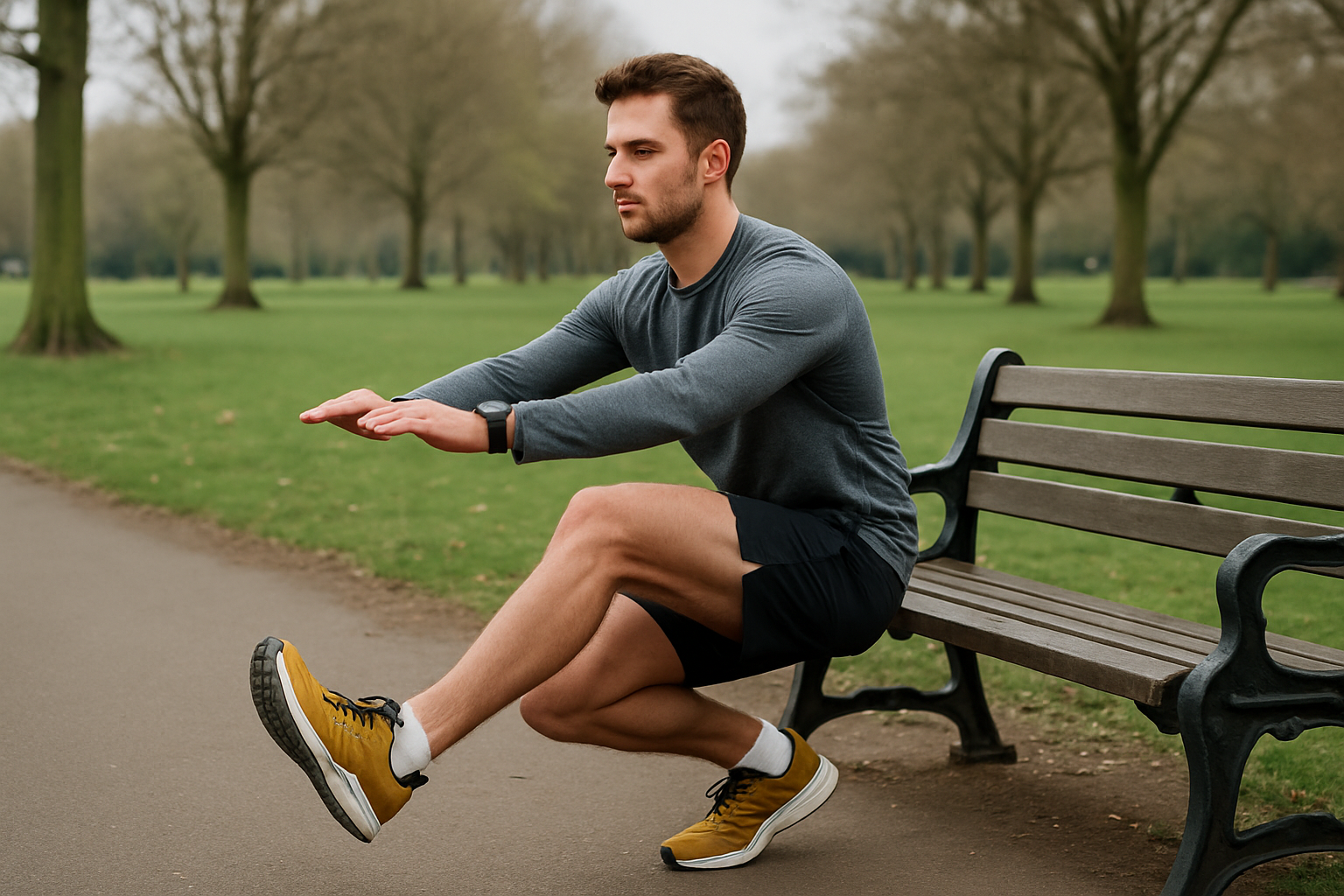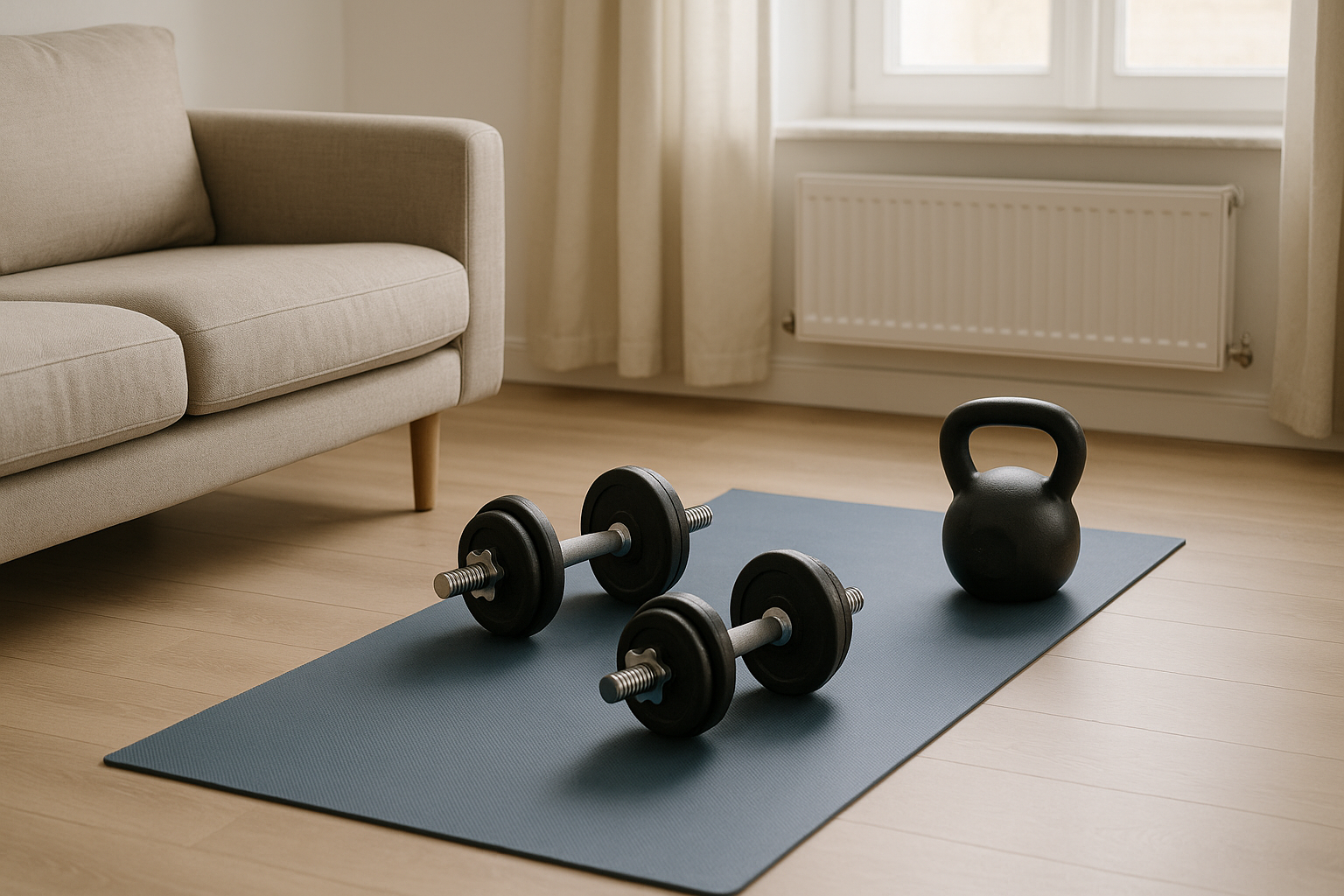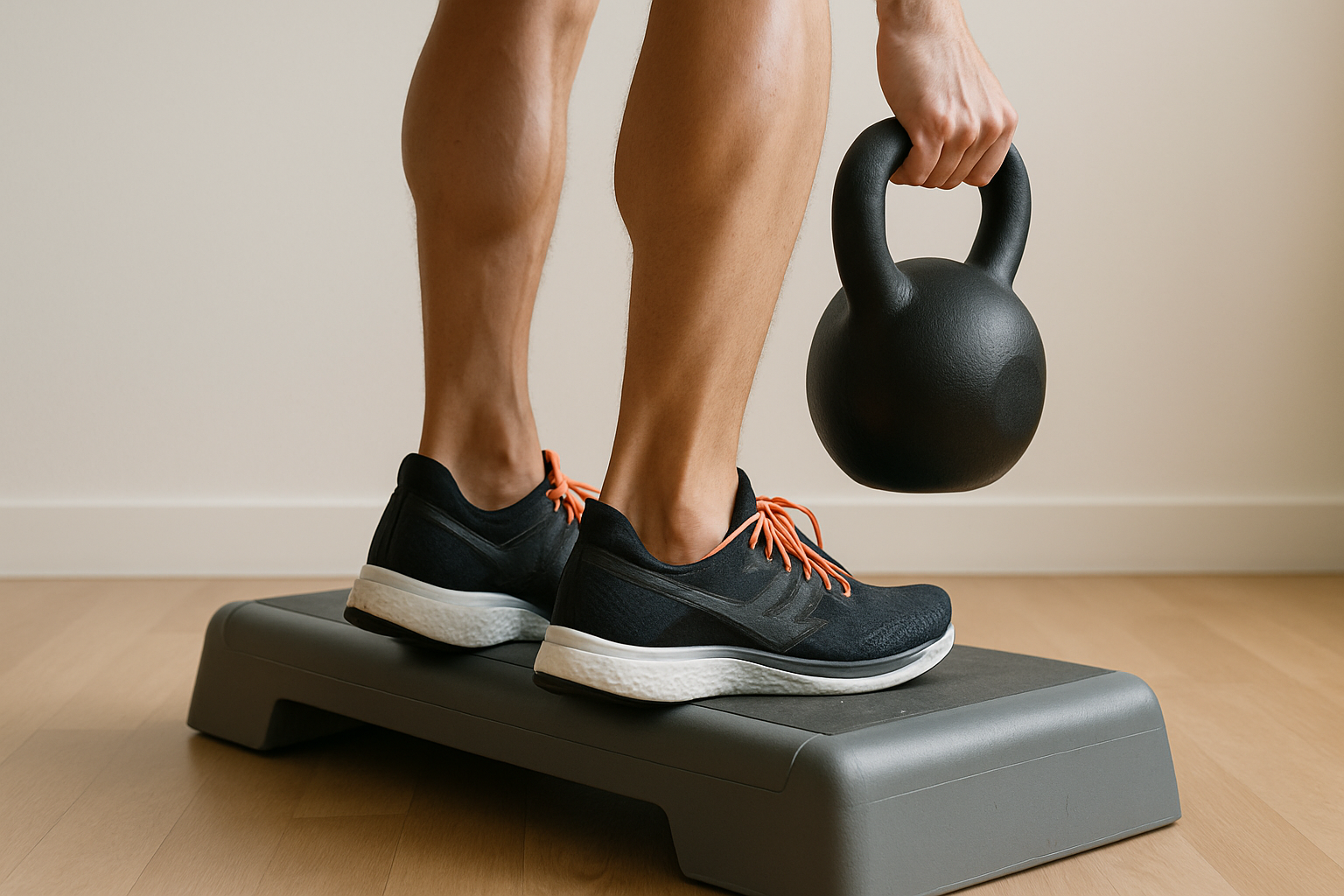Strength Training for Runners at Home (UK Guide)
Reading time: 14–16 minutes
Last updated: September 2025
Strength training for runners at home (UK Guide)
If you run for fitness or races, adding strength training for runners can make you faster, more robust, and less injury-prone. This expert UK guide shows you exactly what to do at home, how often to lift, and which exercises deliver the biggest gains with minimal kit.
- Quick answers: Do 2 strength sessions per week focused on lower-body, core and single-leg control. Use compound lifts (squats, hinges, lunges), calf work, hamstring bridges, and trunk stability. You can start with bodyweight and bands; dumbbells or a kettlebell improve progress. Expect better running economy in 6–8 weeks.
TL;DR
- Two 30–45 minute sessions per week improve running economy, power and resilience.
- Prioritise squats, Romanian deadlifts, split squats, calf raises, hamstring bridges, and anti-rotation core.
- Progress load over time: start bodyweight/bands, then add 6–20 kg dumbbells or a 12–20 kg kettlebell.
- Keep easy runs easy on strength days; do hard runs on separate days where possible.
- In UK homes/flats, choose quiet kit: bands, rubber-coated dumbbells, and floor-friendly mats.
- Most see benefits within 6–8 weeks; maintain 1–2 sessions weekly during race season.
Table of contents
- Strength training for runners: what it is and why it works
- How often, how heavy, and when to fit it around runs
- Home equipment: essentials, budgets and noise/space tips
- Home setup for UK houses and flats
- 6-week programmes by level (+ warm-up and cooldown)
- Technique cues for key lifts
- Injury prevention, recovery and sleep
- Nutrition basics for strength + running
- Alternatives and smart cross-training
- Budget tiers: what to buy now vs later
- Maintenance and kit longevity
- Troubleshooting common issues
- FAQs
- Short glossary
- Verdict and next steps
Strength training for runners: what it is and why it works
Strength training for runners means targeted resistance work to improve force production, stiffness in the tendons, and control in single-leg positions. The outcomes are practical: better stride efficiency, stronger push-off, and fewer niggles.
- Performance: Resistance training improves running economy and time-trial performance in distance runners (systematic reviews/meta-analyses support this). See summaries via PubMed and BASES expert statements.
- Injury risk: Strength and balance work reduce lower-limb injury risk by enhancing tissue capacity and control. The UK Chief Medical Officers also recommend muscle-strengthening activities twice weekly for health and function (CMO Guidelines).

How often, how heavy, and when to fit it around runs
How often: 2 sessions per week hits the sweet spot for most runners (20–45 minutes). One session maintains; three can help advanced runners outside of peak race weeks.
How heavy: Use an effort that leaves 1–3 reps in reserve (RIR) on main lifts. For bodyweight or bands, slow eccentrics (3–4 seconds down) and pauses increase stimulus. Progress to 6–12 rep sets with meaningful load.
When to fit it: Put strength on easy-run days or the day after a rest day. Avoid heavy lower-body lifting within 24–36 hours of key track sessions or long runs. Keep a 48-hour buffer before races.
Home equipment: essentials, budgets and noise/space tips
You can start with bodyweight. Small additions make progress easier and quieter for neighbours.
- Resistance bands (loop + long): £15–£30 – quiet, portable, great for warm-ups and accessory work.
- Dumbbells: £2–£4 per kg; a pair of 6–12 kg suits many beginners; adjustable dumbbells (£150–£350) are space-efficient.
- Kettlebell: 12–20 kg (£30–£80) covers hinges, squats, carries, and power work.
- Mat: £20–£40 – reduces noise and protects floors.
- Optional: Foldable bench (£60–£120), door anchor for bands (£10–£15).
Building a more complete setup over time? See how to build a home gym for spacing and smart purchases.
Home setup for UK houses and flats
- Space: 2 × 2 m is enough for most sessions. Train lengthways in a hallway if needed.
- Noise: Use a 10 mm+ mat, control the eccentric (no dropping weights), and choose rubber-coated dumbbells.
- Storage: A small crate for bands and a vertical stand for dumbbells keeps clutter down.
6-week programmes by level (+ warm-up and cooldown)
The templates below target the main running needs: knee control, hip and ankle strength, calf-tendon capacity, hamstring resilience, and trunk stability.
Warm-up (6–8 minutes)
- Foot rockers and ankle circles × 20 each
- Glute bridge with 2-second pause × 10
- World’s greatest stretch × 5/side
- B-stance squat-to-stand × 8/side
- Marching A-steps or high-knee marches × 30–45 seconds
Beginner (2×/week, 30–35 minutes)
Week 1–2: 2 sets; Week 3–4: 3 sets; Week 5–6: add load or tempo (3 seconds down). Rest 60–90 seconds between sets.
- Goblet squat or bodyweight box squat: 8–10 reps
- Hip hinge (dumbbell/kettlebell Romanian deadlift): 8–10 reps
- Split squat (rear-foot on floor): 6–8/leg
- Calf raises (straight knee): 12–15; add bent-knee raises: 10–12
- Hamstring bridge (feet on floor or small step): 8–10 with 2-second pause
- Anti-rotation press (band Pallof press): 8–12/side
- Dead bug or hollow hold: 20–30 seconds
Progression: Increase dumbbell weight by 1–2 kg when you can complete top reps with 2+ RIR. For bodyweight, slow the lowering phase and add pauses.
Intermediate (2×/week, 35–45 minutes)
Use moderate loads (6–12 reps) leaving 1–3 RIR. Rest 90 seconds between main sets.
- Front-foot-elevated split squat: 3 × 6–8/leg
- Romanian deadlift (two dumbbells or kettlebell): 3 × 6–8
- Single-leg squat to box (or assisted): 3 × 5–6/leg
- Seated calf raise (bent-knee, weighted): 3 × 10–12
- Standing calf raise (straight-knee, slow 3-second down): 3 × 10–12
- Nordic hamstring curl (assisted) or Swiss-ball ham curl: 3 × 5–8
- Anti-rotation press + carry (suitcase carry 15–25 m): 2 rounds
Plyo option (off-season only): After the main lifts, add 2 × 8 pogo jumps and 2 × 6 split squat jumps (full recovery). Skip in race weeks.
Weekly schedule example
- Mon: Easy run + Strength A
- Tue: Easy/moderate run
- Wed: Intervals/tempo
- Thu: Rest or easy cross-training
- Fri: Easy run + Strength B
- Sat: Rest or short shakeout
- Sun: Long run
If you’re following a treadmill running plan, see our treadmill 5k training plan and place strength after easy treadmill days.
Cooldown (5 minutes)
- Calf and hip flexor stretches: 30–45 seconds each
- 90/90 hip rotations: 6/side
- Breathing reset (box breathing): 2 minutes

Technique cues for key lifts
Goblet squat
- Brace ribs down, hold the bell close to your chest.
- Knees track over middle toes; sit “between” your hips.
- Pause briefly at the bottom; drive through mid-foot.
Romanian deadlift
- Soft knees; push hips back like closing a car door.
- Keep weights close to thighs; spine long, not rounded.
- Stop when hamstrings feel tight; stand tall with glutes.
Split squat
- Front foot heavy; back heel lifted.
- Drop straight down; knee tracks over second toe.
- Keep pelvis square; slight forward torso lean is ok.
Calf raises
- Go through full range: heels just below step, then high on toes.
- Pause 1 second at the top; control the descent (2–3 seconds).
- Film a side view for 1–2 sets to check depth, posture and knee tracking.
- Use shoes with firm soles or go socks-only for better ground feel on squats/hinges.
- Add a 2–3 second pause in weak positions to build control fast.
- Doing circuits too fast. You’re training strength, not cardio—rest enough to lift well.
- Skipping calves/hamstrings—both protect your Achilles and knees on hills and speed work.
- Changing too many variables at once. Progress either load, reps, or tempo each week.
Injury prevention, recovery and sleep
- Load management: Increase total weekly lifting volume by no more than ~10–15%.
- DOMS vs injury: Mild soreness for 24–48 hours is normal when starting; sharp or worsening joint pain isn’t. See the NHS for exercise safety guidance.
- Sleep: Aim for 7–9 hours; sleep loss reduces adaptation and increases injury risk.
- Easy days easy: Keep easy runs truly easy (conversational) after heavy lifts.
Nutrition basics for strength + running
- Protein: 1.2–1.8 g/kg/day in 2–4 meals supports strength gains and recovery.
- Carbs: Fuel quality sessions: 1–2 g/kg in the 3–4 hours before hard runs or lifts.
- Hydration: 2–3 ml/kg 2 hours pre-session; sip during long sessions. Include electrolytes on hot days.
- Post-session: Within 2 hours, eat a mixed meal (20–40 g protein + carbs).
Alternatives and smart cross-training
On cutback weeks or if an injury limits running, low-impact cardio keeps your engine ticking while you maintain strength work.
- Rowing: Full-body, posterior-chain friendly, and easy to do at home. Compare options in our best rowing machines. For a popular budget air rower, see our BodyMax Oxbridge HR Air Rowing Machine review.
- Elliptical/cross-trainer: Running-like pattern without impact; good for aerobic work between heavy leg days. A compact option is discussed in the JLL CT100 review.
Bands: cheapest and quietest; best for warm-up and accessories. Dumbbells: easiest progressive overload. Kettlebell: versatile for hinges, squats and carries. Machines: convenient but larger and costlier.
Budget tiers: what to buy now vs later
- £0–£40: Bodyweight + bands + mat. Focus on tempo, pauses, single-leg control.
- £100–£250: Add adjustable dumbbells (up to ~20 kg each) or a kettlebell pair (12 kg + 16–20 kg).
- £250–£500: Heavier dumbbells, foldable bench, more bands. Great for long-term progression.
Prices reflect typical UK RRP as of 2025 and may vary by retailer.
Maintenance and kit longevity
- Inspect bands monthly for tears; replace at first signs of cracking.
- Wipe dumbbells/kettlebells dry after use; avoid damp storage.
- Rotate grips and foot positions to spread stress and keep joints happy.
Troubleshooting common issues
- Sore knees in squats/lunges: Shorten range slightly, keep knee tracking over the second toe, and strengthen calves/hamstrings. Elevate front foot for better hip mechanics.
- Achilles tightness: Reduce plyometrics, increase bent-knee calf work, and keep progressions gradual.
- Hamstring cramps: Swap to hip-dominant hinges and bridge variations; add hydration and slow eccentrics.
- Plateau: Add 1 set to main lifts or increase load 1–2 kg; reduce junk miles to recover better.
FAQs
How many days a week should runners lift?
Two days per week suits most. One day maintains during heavy race blocks; three days works in off-season.
Should I lift before or after running?
On easy days, lift after an easy run or in a separate PM slot. Avoid heavy lower-body work just before speed/long runs.
Do I need a gym for meaningful results?
No. Bands and 6–20 kg dumbbells/kettlebells can drive progress for months.
Will lifting make me heavier and slower?
Not if programmed for runners. Expect better economy and power with minimal mass gain, especially at 6–12 reps and moderate volumes.
When will I notice benefits?
Commonly within 6–8 weeks—improved hill strength, form late in long runs, and fewer niggles.
What about plyometrics?
Useful in off-season: small volumes of jumps improve stiffness and speed. Keep total contacts low and avoid close to races.
Can I combine a treadmill plan with lifting?
Yes—slot strength after easy treadmill runs. If you’re new, try our treadmill 5k training plan.

Short glossary
- RIR (Reps In Reserve): How many reps you could have done before failure.
- Running economy: Oxygen cost at a given pace—lower is better.
- Hinge: Hip-dominant movement like the Romanian deadlift.
Verdict and next steps
Two structured strength sessions per week—anchored by squats, hinges, split squats, calf work and trunk stability—deliver big returns for runners. Start with bodyweight and bands, layer in dumbbells or a kettlebell, and progress tempo or load gradually. Keep heavy lifts away from key runs and you’ll run stronger with fewer setbacks.
Next steps: set up a small home corner, pick your beginner or intermediate template above, and review cross-training options in our best rowing machines. If you’re expanding your space, read how to build a home gym, and for compact cardio ideas see the BodyMax Oxbridge HR Air Rowing Machine review and the JLL CT100 review.
Related reading
Evidence notes: Strength training supports running economy and durability (e.g., meta-analyses on PubMed; see Yamamoto et al.). The UK Chief Medical Officers recommend muscle-strengthening activities twice weekly for adults; see the CMO Physical Activity Guidelines. For general safety advice, consult the NHS.
Disclaimer: This guide is for general information only and is not a substitute for medical advice. If you have a medical condition, injury, or are new to exercise, consult your GP or a qualified professional before starting.